I spent a lot of summer days in my childhood jumping rope, so when we heard about a precision jumprope team in our area, we had to investigate. My kids joined the group and learned some amazing acrobatic tricks that make jumping rope much more fun and a great way to impress your friends! In this Workshop Wednesday, we will also move beyond merely jumping the ropes and explore some other ideas that will show you how to use jumpropes in making ordinary lessons extraordinary! These tips will take lessons off the table and out of the classroom and make them into kinesthetic learning fun!
Jumping rope is a great strength and stamina building activity, which is why boxers and other athletes use it as part of their training. Before we get started in the how-to’s of fancier jumping, let’s talk over some basics. Speed ropes are best for this type of activity; a speed rope is plastic or vinyl but may be solid or a hollow tube, with handles that spin freely. To get your rope to the perfect size for your body, stand on the middle of the rope and pull the handles up as high as they will go: the handles should come up to your shoulders. To shorten a rope, untie the knot in one end and retie it at the appropriate length, sliding the handles back in place; you can cut off the excess rope if you wish, or keep some extra length for kids who are still growing. If your rope is too short, you will be more likely to trip over it; if your rope is made of something soft like braided cotton roping, it will move too slowly and mess up your timing.
Ow! If you are new to jumping rope or haven’t done it for a long time, you will probably experience a painful side-ache after an extended period of steady jumping. This is an indication that you are retaining too much carbon dioxide from breathing in more than you are breathing out. You can remedy this situation by exhaling forcibly for a count of 5, then inhale for only a count of 3, and repeat until the ache is gone. I know it hurts, and this is hard to do when all you want to do is gasp for more air, but controlling your breathing like this for about a minute will dissolve that pain! The more you practice jumping rope, the quicker you will get in shape, and the sooner those side-aches will be a thing of the past. Trust me.
If you’re all practiced up and ready to move beyond ordinary rope-skipping, try using a jumping-jack technique: move your feet about shoulder-width apart on one jump, then bring them back together on the next jump, repeating the out-in-out-in movement over and over. Another variation is a forward-backward jump: jump a half-step forward on the first jump, then jump back a step on the next jump, repeating the forward-backward-forward-backward motion. Another move that is fun to watch (and impresses your friends) is called the Slalom: move both feet to the left on one jump, then move both feet to the right on the next jump, repeating left-right-left-right.
As your legs get stronger, you can try squatting down on one jump, then standing up on the next: up-down-up-down. When your muscles are ready for a really big challenge, try the Cossack, which resembles a Russian Cossack dance done while jumping rope: squat down for jump #1, extend your right leg on jump #2, pull in your leg again for jump #3, extend your left leg for jump #4, and repeat jumps 1-4. Every jump takes place in a squatting position, but you hop up and down a little as you jump the rope and switch your legs out and in. Try practicing the leg moves without the rope first for best results. It takes lots of strength and coordination to do this one, but no one who sees you perform it will ever forget it, and they may ask you to show it off to everyone who comes along!
Once these basics steps have been mastered, you can use them to make boring lessons more interesting. Mom can call out a spelling word for the student to spell out loud while jumping. Mom can hold up math flashcards, and the jumping student can call out the answers. What other basic facts could be reviewed while jumping rope? Try defining vocabulary words, giving examples of parts of speech, calling out matching states and capitals, and so on. The jumprope games of my youth incorporated counting rhymes, but today’s kids could use songs, raps, or poems for whatever subject they are learning and give an auditory element to their learning-while-jumping.
After everyone’s tired from all that jumping, the jumpropes can still help out in lessons. Lay several ropes in the grass or on the floor in vertical parallel lines and create a timeline, using the ropes for century divisions. Hang a name tag around Barbie’s neck and let her represent Betsy Ross. GI Joe can receive a similar name tag and become Jim Bowie at the Alamo. My Little Pony might represent the Cavalry at the battle of Little Big Horn, and a tiny model of the Empire State Building can be built from Legos, and all of these historical people and events (and more) can be placed in the appropriate places in your time line. Those same parallel ropes could be used for lanes in a relay race or as part of an obstacle course, and please don’t overlook the obvious math lesson concepts of vertical, horizontal, parallel, and perpendicular.
Now let’s rearrange the ropes a little to make a hopscotch pattern on the grass, as a nice change from playing hopscotch on hard concrete. Tennis balls can be used instead of rocks for the marking “stones,” and the squares can be marked with numbers or other information written on large pieces of paper or cereal box cardboard, held in place with shoes, bricks, or anything heavy that won’t blow away on windy days. Remove the obstacles and add a garden hose and a sprinkler for some hot weather fun!
Another rearrangement of the ropes can create a giant tic-tac-toe grid on your lawn. Use extra shoes or sports balls for the markers. Little ones can walk across the grid to place their markers, but older kids will enjoy the challenge of standing behind a marked line (another jumprope!) and trying to toss their markers onto the correct squares. Objects that bounce and roll will only add to the challenge and the fun.
Our lessons for today wouldn’t be complete without making gigantic Venn diagrams with our jumpropes. This example shows square things in the left group, red things in the right group, and square red things in the intersection of the two groups. Challenge your students to create their own Venn diagrams for practice in understanding the various ways objects can be categorized, perhaps using sports equipment, toys, shoes, or anything that can be sorted appropriately. Jumpropes can also be used indoors for this type of jumbo lessons on the floor.
See also:
Hopscotch–A Powerful Learning Game
Kinesthetic Learners

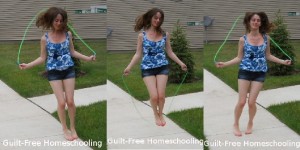

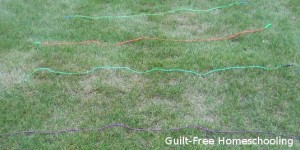
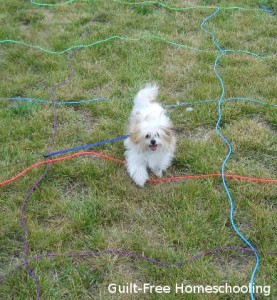
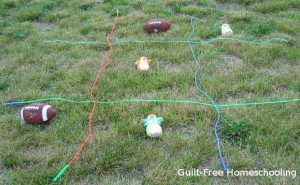
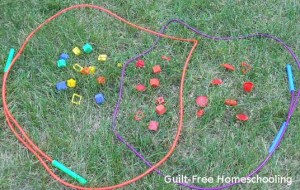


 Guilt-Free Homeschooling is the creation of Carolyn Morrison and her daughter, Jennifer Leonhard. After serious disappointments with public school, Carolyn spent the next 11 years homeschooling her two children, from elementary to high school graduation and college admission. Refusing to force new homeschooling families to re-invent the wheel, Carolyn and Jennifer now share their encouragement, support, tips, and tricks, filling their blog with "all the answers we were looking for as a new-to-homeschooling family" and making this website a valuable resource for parents, not just a daily journal. Guilt-Free Homeschooling -- Equipping Parents for Homeschooling Success!
Guilt-Free Homeschooling is the creation of Carolyn Morrison and her daughter, Jennifer Leonhard. After serious disappointments with public school, Carolyn spent the next 11 years homeschooling her two children, from elementary to high school graduation and college admission. Refusing to force new homeschooling families to re-invent the wheel, Carolyn and Jennifer now share their encouragement, support, tips, and tricks, filling their blog with "all the answers we were looking for as a new-to-homeschooling family" and making this website a valuable resource for parents, not just a daily journal. Guilt-Free Homeschooling -- Equipping Parents for Homeschooling Success!

This was such a great article about jump ropes , I never heard of precision jump rope but after reading your article and sharing it with my children we are definitely going to give it a try. This sounds fun and it also helps keep the kids active and I never thought about making your jump ropes into hop scotch. Thank you for sharing this post with us Carolyn!
You can look for “jump rope team” on You Tube for some spectacular videos of precision teams in action. I didn’t include that in the above article, because I wanted to focus more on the individual and family aspects rather than team efforts. Jump rope *teams* require great strength, athleticism, and constant practice to get all the choreography and timing exactly perfect! The videos are very inspiring, but like any trained athletes, they can make it look so simple!!!